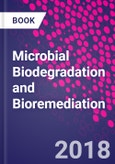Microbial Biodegradation and Bioremediation brings together experts in relevant fields to describe the successful application of microbes and their derivatives for bioremediation of potentially toxic and relatively novel compounds. This single-source reference encompasses all categories of pollutants and their applications in a convenient, comprehensive package.
Our natural biodiversity and environment is in danger due to the release of continuously emerging potential pollutants by anthropogenic activities. Though many attempts have been made to eradicate and remediate these noxious elements, every day thousands of xenobiotics of relatively new entities emerge, thus worsening the situation. Primitive microorganisms are highly adaptable to toxic environments, and can reduce the load of toxic elements by their successful transformation and remediation.
Table of Contents
Chapter 1 Microbial bioremediation: a potential tool for restoration of the contaminated areasChapter 2 Heavy metals and hydrocarbons: Adverse effects and mechanism of toxicity
Chapter 3 Nanotoxicity: Aspects and concerns in biological systems
Chapter 4 Application of molecular techniques for assessment of microbial communities in contaminated sites
Chapter 5 Microbial indicators for monitoring pollution and bioremediation
Chapter 6 Bioremediation of mercury: A genetic engineering approach
Chapter 7 Bio-surfactant based bioremediation of toxic metals
Chapter 8 Biofilm mediated bioremediation of PAHs
Chapter 9 Nano-particle based bioremediation
Chapter 10 Bioremediation using extremophiles
Chapter 11 Role of Actinobacteria in bioremediation
Chapter 12 Biology, genetic aspects and oxidative stress response of Streptomyces and strategies for bioremediation of toxic metals
Chapter 13 Fungal bioremediation strategies
Chapter 14 Microbial bioremediation of industrial effluents
Chapter 15 Bioremediation of polythene wastes
Chapter 16 Phycoremediation of contaminated water and soil coupled with generation of value added products
Chapter 17 Feasibility of using microbial fuel cell technology for bioremediation
Chapter 18 Microbial bioremediation: A metagenomic approach
Chapter 19 In-silico approach in bioremediation
Chapter 20 Bioremediation of greenhouse gases with microalgae
Chapter 21 Bio-Reactor and enzymatic reactions in bioremediation
Chapter 22 Microbiological metabolism under chemical stress
Chapter 23 Bioremediation of pesticides: A case study
Chapter 24 Microalgae in removal of heavy metal and organic pollutants from soil
Chapter 25 Bioremediation of aquaculture effluents
Chapter 26 Aquifer microbiology of different geogenic setting for environmental biogeotechnology
Chapter 27 Exploring prospects of mono-oxygenases based bio-catalyst in xenobiotics and their computational modelling








